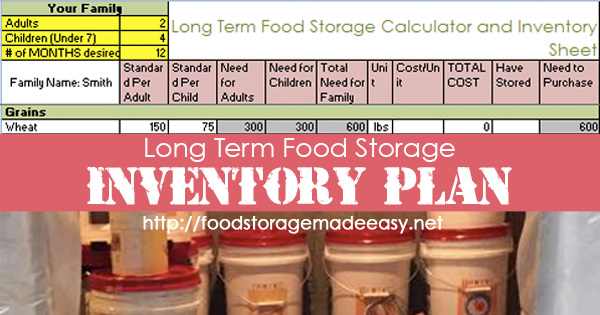In case you haven’t been following along, this year Jodi and I have decided to do a complete Food Storage Do-Over and go step-by-step re-evaluating our entire food storage plan. We are working on one topic each week and this week is our long term food storage planning week. When we started our food storage journey, I had one little guy who was 18 months. Now I’m about to have my fourth son and I can certainly tell you my family eats more NOW than they did 6 years ago. It was nice to have a chance to really take a look at my plan again and make sure it’s meeting my current needs.
When you are making your long term food storage plan, PLAN on it changing.
So here is what I did now that we have another boy on the way. Making the plan for what I still need is where I always start. Today I’m going to share with you how I determined what I still need to buy in my basic long term food storage.
1. First I re-downloaded our food storage calculator. This calculator contains the standard “food storage” foods that typically have long shelf lives. It’s basic life sustaining foods. My goal is to store a year supply of these foods and supplement with fruits, vegetables, meats, and cheeses. This actually gives me longer than a year supply, but I also have boys who eat more than regular boys so I figure it evens it out. So this is what it looks like when I say 2 adults and 4 kids.
2. Second I altered the calculator right in the spreadsheet to work with my family’s needs. For example:
- I added in quinoa and take out a lot of cornmeal. With grains you can exchange pound for pound. I mess around with the pounds of grains until it’s a make up that suits more of what my family eats. You can do this percentage wise if you don’t know it pound wise.
- I replaced some of the vegetable oil requirements with coconut oil and olive oil since that is what we eat more often.
- I also replaced some of the sugar with honey and pure maple syrup. I know those items are more expensive but again, we don’t eat much white sugar so I feel like it’s wasteful to store and I don’t rotate it.
- I increased the amount of powdered eggs I store because I know I use them a lot in pancakes in daily life, let alone an emergency, and it’s simply not enough.
- I did a few other minor changes taking out/replacing foods we don’t eat.
3. Next I printed my spreadsheet and brought it with me to the food storage room. I inventoried what I had with a pencil right on the paper. Since I have a lot of my food storage already I didn’t worry about the cost and cost per units for now because I’ll only look into it on the items I need to buy when I need to buy them.
4. With my printed paper I updated the spreadsheet and watched all the numbers fill in for what I still needed to buy. It was as “easy” as that!
This has gotten easier and easier each time. Over the past 6 years our diets have changed but we are in a pretty consistent phase right now. We eat from our food storage foods and rotate fairly easy. If anything this do-over week has taught me investing the time into learning about food storage foods and getting comfortable using them has been well worth it.

-Jodi Weiss Schroeder
http://foodstoragemadeeasy.net




